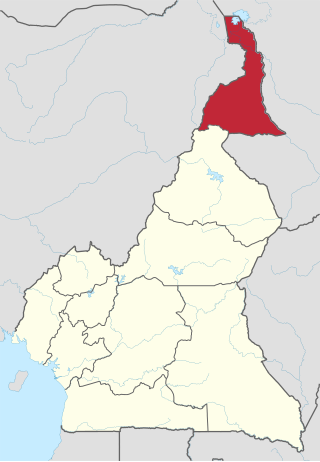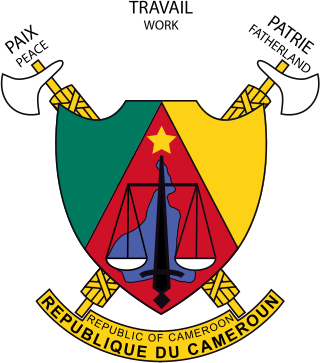
Cameroon, officially the Republic of Cameroon, is a country in Central Africa. It shares boundaries with Nigeria to the west and north, Chad to the northeast, the Central African Republic to the east, and Equatorial Guinea, Gabon and the Republic of the Congo to the south. Its coastline lies on the Bight of Biafra, part of the Gulf of Guinea and the Atlantic Ocean. Due to its strategic position at the crossroads between West Africa and Central Africa, it has been categorized as being in both camps. Its nearly 27 million people speak 250 native languages, in addition to the national tongues of English and French, or both.
At the crossroads of West Africa and Central Africa, the territory of what is now Cameroon has seen human habitation since some time in the Middle Paleolithic, likely no later than 130,000 years ago. The earliest discovered archaeological evidence of humans dates from around 30,000 years ago at Shum Laka. The Bamenda highlands in western Cameroon near the border with Nigeria are the most likely origin for the Bantu peoples, whose language and culture came to dominate most of central and southern Africa between 1000 BCE and 1000 CE.

Ifá is a divination system originating among the Yoruba people of West Africa. It plays an important role in Yoruba religion and certain African diasporic religions deriving from it, such as Cuban Santería.
Articles related to Cameroon include:

The North Region makes up 66,090 km2 of the northern half of The Republic of Cameroon. Neighbouring territories include the Far North Region to the north, the Adamawa Region to the south, Nigeria to the west, Chad to the east, and Central African Republic to the southeast. The city of Garoua is both the political and industrial capital. Garoua is Cameroon's third largest port, despite the fact that the Bénoué River upon which it relies is only navigable for short periods of the year.

The Kirdi are the many cultures and ethnic groups who inhabit northwestern Cameroon and northeastern Nigeria.
Nggam is a type of divination found among many groups in western Cameroon. Among the best documented is its practice by the Mambila people of Cameroon and Nigeria, in which the actions of spiders or crabs are interpreted by the diviner. The form used by the neighbouring Yamba people was described by Gebauer in 1964 based on experience in Mbem going back to before 1939, and more recently by Hermann Gufler. Good documentation of Nggam has been also published for the Bekpak (Bafia) people by Dugast and for Bamileke people by Pradeles de Latour. The crab form has been studied in north Cameroon by Walter van Beek.

The Far North Region, also known as the Extreme North Region, is the northernmost and most populous constituent province of the Republic of Cameroon. It borders the North Region to the south, Chad to the east, and Nigeria to the west. The capital is Maroua.

Germaine Dieterlen was a French anthropologist. She was a student of Marcel Mauss, worked with noted French anthropologists Marcel Griaule (1898-1956) and Jean Rouch, wrote on a large range of ethnographic topics and made pioneering contributions to the study of myths, initiations, techniques, graphic systems, objects, classifications, ritual and social structure.

The Bassa are a Bantu ethnic group in Cameroon. They number approximately 800,000 individuals. The Bassa speak the Basaa language.

The Sao civilization flourished in Central Africa from ca. the 6th century BCE or 5th century BCE to as late as the 16th century AD. The Sao lived by the Chari River basin in territory that later became part of Cameroon and Chad. They are the earliest civilization to have left clear traces of their presence in the territory of modern Cameroon. Sometime around the 16th century, conversion to Islam changed the cultural identity of the former Sao. Today, several ethnic groups of northern Cameroon and southern Chad, but particularly the Sara and Kotoko, claim descent from the civilization of the Sao.
Jacob Kehinde Olupona is a Nigerian-born American professor, writer, and scholar of religious studies. He is a professor of African Religious Traditions at the Harvard Divinity School with a joint appointment as Professor of African and African American Studies in the Faculty of Arts and Sciences at Harvard University. Olupona was elected to the American Academy of Arts and Sciences in April 2023.
Psikye is an Afro-Asiatic language spoken in northern Cameroon and eastern Nigeria. Varieties include Psikyɛ and Zləngə. Blench (2006) classifies it as a dialect of Kamwe.

Hervé Yamguen is a Cameroonian painter and sculptor. A self-taught artist, he launched himself in painting, sculpture and he discovered a passion for the writing which enables him to wonder about its daily live. He currently works on plays.
Njerep (Njerup) is a Mambiloid language spoken in the Adamawa Region of Cameroon. Njerep is essentially extinct, with only 4 people who speak it at home. Though word lists and grammatical information have been collected from these people, the information remains fragmented.
Iyive, also referred to as Uive, Yiive, Ndir, Asumbos, is a severely endangered Bantoid language spoken in Nigeria and Cameroon. The ethnic group defined by use of this language is the Ndir.

The Mafa, also called Mafahay, is an ethnic group localized in northern Cameroon, Northern Nigeria and also scattered in other countries like Mali, Chad, Sudan, Burkina Faso and Sierra Leone.

African divination is divination practiced by cultures of Africa.

Cameroonian nationality law is regulated by the Constitution of Cameroon, as amended; the Nationality Code of Cameroon, and its revisions; and various international agreements to which the country is a signatory. These laws determine who is, or is eligible to be, a national of Cameroon. The legal means to acquire nationality, formal legal membership in a nation, differ from the domestic relationship of rights and obligations between a national and the nation, known as citizenship. Cameroonian nationality is typically obtained under the principle of jus sanguinis, i.e. by birth in Cameroon or abroad to parents with Cameroonian nationality. It can be granted to persons with an affiliation to the country, or to a permanent resident who has lived in the country for a given period of time through naturalization.
Muhammad Hamman Yaji (1863-1929) was Emir of Madagali, Nigeria, part of the Adamawa Emirate. Known for his personal diary recording his daily life and activities from 1912 to 1927, he was a Fulbe raider and slave trader near the border of present-day Adamawa State, Nigeria, and Mayo-Tsanaga, Far North Region, Cameroon. Originally written in Arabic, his diary provides a rare local perspective on early 20th century sub-Saharan daily life under colonial rule.

















